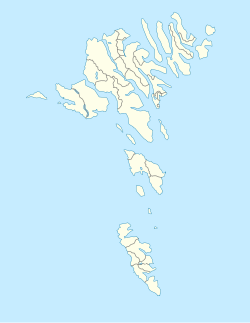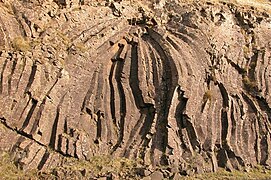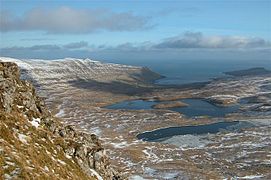
The Faroe Islands is served by an internal transport system based on roads, ferries, and helicopters. As of the 1970s, the majority of the population centres of the Faroe Islands have been joined to a single road network, connected by bridges and tunnels.

Fámjin is a village located on the western side of Suðuroy, the southernmost island in Faroe Islands. Fámjin is looking directly out to the North Atlantic Ocean.

Klaksvík is the second largest town of the Faroe Islands behind Tórshavn. The town is located on Borðoy, which is one of the northernmost islands. It is the administrative centre of Klaksvík municipality.

Tvøroyri is a village on the north side of the Trongisvágsfjørður on the east coast of Suðuroy island in the Faroe Islands. Together with Froðba, Trongisvágur, Líðin and Øravík it forms Tvøroyri Municipality.

Porkeri is a village in the Faroe Islands, situated northeast of Vágur on Suðuroy's east coast.

Suðuroy is the southernmost of the Faroe Islands. The island covers 163.7 square kilometres (63.2 sq mi). In 2018 the population was 4,601. Suðuroy region (sýsla) comprises this island and Lítla Dímun, the next isle northward in the Faroes, which is uninhabited.

Sørvágur is a village on the island of Vágar in the Faroe Islands.

Sandvík is the northernmost village of the island of Suðuroy in the Faroe Islands. It is situated on the northern side of a shallow fjord. The village was previously known as Hvalvík. It changed its name to Sandvík in 1913 as there was too much confusion regarding mail delivery, because there is another village named Hvalvík on Streymoy. The village had originally been known as Sandvík during the Viking Age.

Sumba is the southernmost village of the Faroe Islands, located on the island of Suðuroy. It is located in Sumbiar Municipality.

Vágur, meaning bay, is a town and municipality on the island of Suðuroy, part of the Faroe Islands.
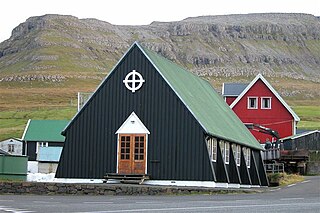
Øravík is a village on the east coast of the island of Suðuroy in the Faroe Islands.

Vágs Bóltfelag (VB) is a Faroese handball club. It started as a football club, which was founded on 5 June 1905, but later the sport handball became a part of the club. The handball club is based in Vágur in Suðuroy. They play their home matches in the sports hall, Vágshøll on Eiðinum in Vágur. The football club is now known as FC Suðuroy.

The national language of the Faroe Islands is Faroese. The Faroese language is a Germanic language which is descended from Old Norse. Danish is the official second language.

Aggi Ásgerð Ásgeirsdóttir is a Faroese artist. She was born in Tórshavn, Faroe Islands. She was educated in Denmark and then moved back to the Faroe Islands, to the small village of Vágur in Suðuroy, which is the southernmost island. In the summer 2009 Aggi moved to Tórshavn or to Argir, now part of the municipality of Tórshavn. While Aggi was living in Suðuroy, her art was her main occupation, and also mentored Ruth Smith Art Museum in Vágur, she was the chairman of the association "Skálin við Skálá", which owns the museum. Aggi often showed the museum for tourists while she was living in Vágur.

Bjarni Johansen is a Faroese politician and former goal keeper. He is the current mayor of Vágur Municipality, elected for the Social Democratic Party in November 2020 to the Municipality and became mayor from 1 January 2021. He is former chairman for the Faroese football association FC Suðuroy.

Vágsfjørður is a fjord on the island of Suðuroy in the Faroe Islands. The fjord is located in the southern part and on the eastern side of the island. The distance between the east and the west coast of Suðuroy is very short from Vágsfjørður to Vágseiði. Between the fjord and Vágseiði is a lake which is called Vatnið. There are five villages around the fjord. In the bottom of the fjord is Vágur, which is one of the largest of the villages in Suðuroy. Further east on the northern side of the fjord is Porkeri, in between Vágur and Porkeri is the small village Nes, where a famous artist Ruth Smith lived. She drowned while swimming in Vágsfjørður at the age of 45.

Borgarknappur is a mountain in Suðuroy, Faroe Islands.
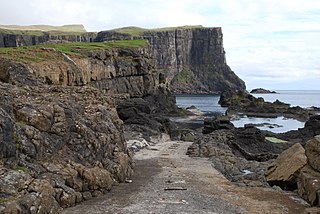
Vágseiði is an area in Vágur, Faroe Islands, located on the west coast of Suðuroy west of the village Vágur, from which it takes its name. Eiði is the Faroese word for isthmus. The distance between the east and the west coast of Vágur is only one km. There is a lake between the village and Vágseiði, the lake is called Vatnið, which is the Faroese word for Lake. The football stadium of FC Suðuroy and the sports hall Vágshøll are located on Vágseiði, 100-200 m from the cliffs. The natural harbour on Vágseiði is called Kleivin. The 200m high cliff south of Vágseiði is called Skúvanes, and the cliffs from Skúvanes towards south are called Eggjarnar. There is a skerry, which looks like some rocks, in the bay of Vágseiði, this skerry is called Heltnarnar. The sea is often rough here and the waves often break against the cliffs here, and often Heltnarnar almost disappear in the surf.
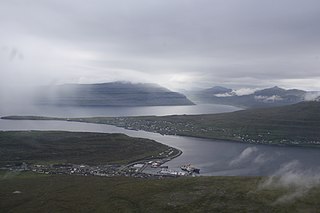
The Faroe Islands consist of 18 islands, several of which are deeply incised by fjords.


